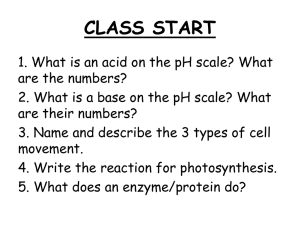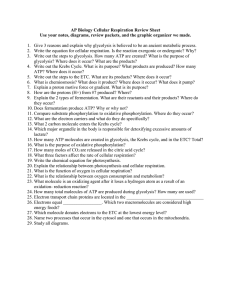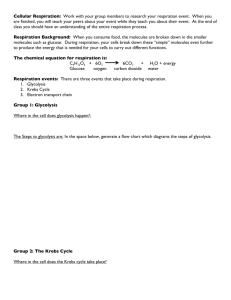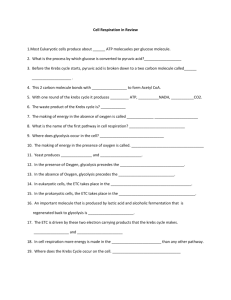Aerobic Respiration
advertisement
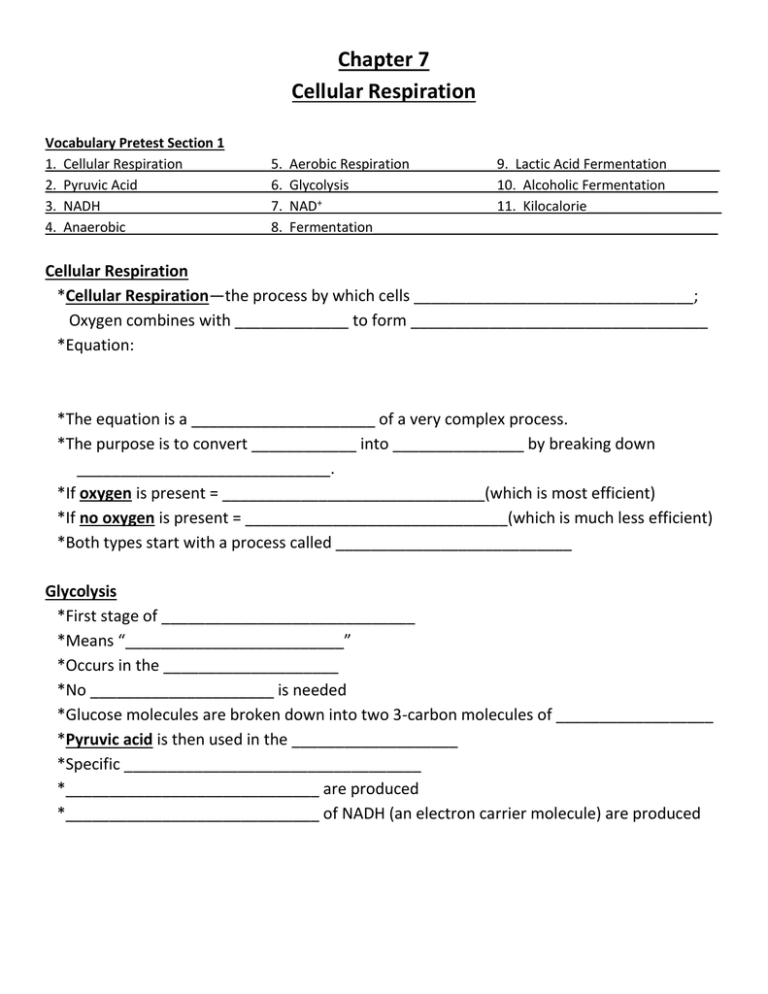
Chapter 7 Cellular Respiration Vocabulary Pretest Section 1 1. Cellular Respiration 2. Pyruvic Acid 3. NADH 4. Anaerobic 5. 6. 7. 8. Aerobic Respiration 9. Lactic Acid Fermentation_______ Glycolysis 10. Alcoholic Fermentation_______ NAD+ 11. Kilocalorie__________________ Fermentation______________________________________________ Cellular Respiration *Cellular Respiration—the process by which cells ________________________________; Oxygen combines with _____________ to form __________________________________ *Equation: *The equation is a _____________________ of a very complex process. *The purpose is to convert ____________ into _______________ by breaking down _____________________________. *If oxygen is present = ______________________________(which is most efficient) *If no oxygen is present = ______________________________(which is much less efficient) *Both types start with a process called ___________________________ Glycolysis *First stage of _____________________________ *Means “_________________________” *Occurs in the ____________________ *No _____________________ is needed *Glucose molecules are broken down into two 3-carbon molecules of __________________ *Pyruvic acid is then used in the ___________________ *Specific __________________________________ *_____________________________ are produced *_____________________________ of NADH (an electron carrier molecule) are produced 4 Stages of Glycolysis 1. 2 phosphates are added to _______________. They are released from 2 molecules of _______ (changing it to _________). Draw the first stage of Glycolysis. 2. The glucose molecule (with its 2 phosphates) is then _________________________ (glyceraldehyde 3-phosphate) Draw the second stage of Glycolysis. 3. Each ________ gets oxidized by adding another phosphate group. Also, electrons and __________________ are removed from the 3C molecule. They are added to ______________________ (nicotinamide adenine dinucleotide) to create ____________ and __________. These will go to the ________________________ Draw the third stage of glycolysis. 4. The phosphate groups are removed from each molecule creating 2 molecules of __________________ (3C). The phosphates are added to 4 molecules of _______ producing __________molecules. Draw the fourth stage of glycolysis. Summary of Glycolysis *___________________ (6C) is broken into two molecules of _____________________ (3C) *If oxygen is available, the ___________________ will move into the __________________ and aerobic respiration will begin. *___________ molecules are produced. ________________ to break apart the next glucose molecule and keep glycolysis going. *This leaves a net yield of _______________________ for use by the cell. *Two _______ are converted into __________ and _______. These go to Electron Transport Efficiency of Glycolysis *Measured in ____________________ (kcal) One kilocalorie = _____________ (cal) *Complete oxidation of glucose releases _______________ *Production of ATP absorbs ______________ *2ATP are produced from every glucose molecule broken down by glycolysis *Efficiency formula: Section 2 Vocabulary Pretest 1. Mitochondrial matrix 2. Acetyl CoA 3. Krebs Cycle 4. Oxaloacetic Acid________________ 5. Citric Acid_____________________ 6. FAD__________________________ Aerobic Respiration *In most cells, the __________________________ produced in glycolysis enters the pathway of ___________________________ *Aerobic respiration produces 20 times as much _____ as is produced by ______________ *______________must be available *Two major stages: __________________________________________________________ Intermediate Step *Aerobic Respiration takes place in the _______________________ *Before the Krebs Cycle can begin, each of the two ______________________________ must be converted. *The pyruvic acid enters the ____________________________ *It reacts with a molecule called ___________________ to form ______________________ Draw the intermediate step: *Notice that acetyl CoA only has 2 carbon atoms *The lost carbon is released in a molecule of _________ *A molecule of NAD+ is reduced to __________________ *Since this happens to both molecules of pyruvic acid the end result is: _______________________________________ _______________________________________ _______________________________________ The Krebs Cycle *Named for ___________________________ *It is a biochemical pathway that breaks down _____________________ *Two turns of the Krebs Cycle produce: 1. ____________________________ 2. ____________________________ 3. ____________________________ 4. ____________________________ 5 Steps of the Krebs Cycle 1. Acetyl CoA combines with ______________________________ to produce Citric Acid. This regenerates and releases CoA. Draw the first stage of The Krebs Cycle 2. ________________ releases a ________ molecule and is oxidized by losing a hydrogen atom. This forms a new 5 carbon compound. The hydrogen atoms is transferred to ___________, reducing it to NADH. Draw the second stage of the Krebs Cycle 3. The 5 carbon compound now releases a ________ molecule and a hydrogen atom. This creates a 4 carbon compound and the hydrogen atom is again added to ________, reducing it to ___________. A molecule of ATP is synthesized from ADP; Draw the third stage of the Krebs Cycle 4. The 4 carbon compound releases a hydrogen atom which is used to reduce _______(Flavin Adenine Dinucleotide) to _________ (FAD also accepts electrons during redox reactions). Draw the fourth stage of the Krebs Cycle 5. The 4 carbon compound now releases a hydrogen atom to regenerate oxaloacetic acid, which can be used to start the Krebs cycle over again. The hydrogen atom released again reduces ___________________________ Draw the last stage of the Krebs Cycle Review of Glycolysis and the Krebs Cycle *In Glycolysis, _________________ molecule produces _____________________molecules, Which can then form two molecules of ______________________ *Both of the Acetyl CoA molecules enter the Krebs Cycle creating two turns of the cycle *This produces _______________________________________________________________ (the CO2 is a waste product that diffuses out of the cell). *The ________________ and _____________ molecules drive the next stage of aerobic respiration---the ________________________________ The Electron Transport Chain *The Electron Transport Chain, linked with ____________________ makes up the second stage of aerobic respiration. *Electrons are transferred from one molecule to another by several electron carrying molecules located in the membrane of the ________________________. *All steps occur in the _______________ (inner membrane) of the mitochondria. Follow the steps of the Electron Transport Chain: 1. ATP is produced when __________ and ___________ release hydrogen atoms (this regenerates NAD+ and FAD, which return to the Krebs Cycle to be reused). Each hydrogen atom gives up electrons and hydrogen ions (H+) 2. The ________________ released move down the chain. They lose energy as they move from molecule to molecule. 3. The lost energy pumps the _____________________ from the matrix to the other side of the membrane. 4. A __________________________ ___of hydrogen ions across the membrane is created. 5. H+ are pumped back in by _______________________ 6. ATP is made from ADP and ____________________ 7. ______________ is the final electron acceptor and also accepts H+ ions to make ____________. Efficiency of Cellular Respiration *Through Aerobic Respiration, a maximum of _____________ molecules can be produced from __________________________________. 2 come from ___________________ 2 come from ____________________ 32-34 come from the ______________________________ Fill in steps if you need them *The actual number of ATP molecules generated through Aerobic Respiration varies from cell to cell (36-38). *Most ____________________________ produce only 36 molecules per glucose molecule because the active transport of __________ uses up some ATP *When 38 ATP molecules are generated the efficiency is calculated by the following formula: *This is _________________ more efficient than glycolysis alone. Anaerobic Respiration *If _____________________is present, the Krebs Cycle and Electron Transport Chain can not work. *The cell must have a way to _____________________________________. *Glycolysis would stop without a process to recycle NAD+ and NADH. *It would use up all the NAD+, Glycolysis would stop and the cell would and die. *Fermentation must kick in to prevent this. Fermentation *Fermentation is the chemical pathway that recycles NAD+ without oxygen. It keeps glycolysis going. No additional _______ is made. *Therefore, you still have a ______________________ efficiency rate for energy release. *Two types of fermentation: 1. ____________________________ 2. ____________________________ Lactic Acid Fermentation *_______________________ is converted by an enzyme into __________________ *Two hydrogen atoms from NADH and H+ are transferred to ______________ to form the Lactic acid molecule. *NADH is oxidized to _________ and reused to keep glycolysis going. *Occurs in foods such as _________________________ *Occurs in _______________________during hard exercise. *Leads to sharp muscle pain----Slow Down!! Alcoholic Fermentation *Converts pyruvic acid to carbon dioxide and _________________________ *NAD+ is recycled in the same manner as before. *Yeast uses this process---producing CO2----causing bread dough to rise. *When the dough is baked, yeast cells die and the ________________________________
